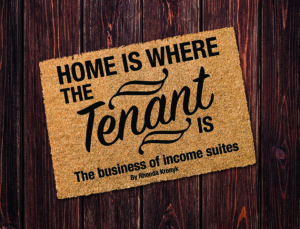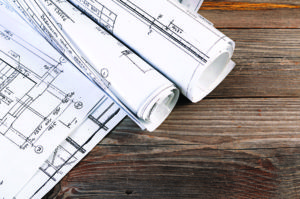Conversations
Income Suites: Home Is Where the Tenant Is - The business of income suites
By Rhonda Kronyk
February, 2017
Owning a home has always been a privilege, but in today’s housing market, that privilege is starting to feel more like a fantasy—especially if you’re a first-time home buyer. But getting into the market isn’t the only hurdle: there’s staying in it, too. And as Canada’s housing market continues to grow—largely fuelled by Toronto, Vancouver and the greater Edmonton area—the number of homeowners overburdened by mortgages is growing, and many are looking for solutions. One of the popular ones? Create an income suite to help cover the mortgage costs and make the dream of home ownership a reality. Here we explore what that looks like in St. Albert.

Affordable Housing
In the capital region, we often think of affordable housing as a City of Edmonton issue. Yet St. Albert’s Affordability Technical Study released in March 2015 estimates that over 4,000 households pay more than 30 percent of their income to meet their housing needs. While that might not seem particularly high, the national measure of affordable housing is 30 percent or lower. Based on the 2011 Canadian Census, 1 in every 6.5 St. Albert homeowners struggles with affordability. This rate is lower in Leduc, Spruce Grove and Edmonton, but higher in Strathcona County and Fort Saskatchewan.
When we dig deeper into those Canadian Census stats, some concerning trends emerge. In 2011, almost 2,000 households reported spending between 30 percent and 50 percent of their income on housing—which places them in the “moderately cost burdened” category. Furthermore, approximately 1,300 homeowners reported spending more than 50 percent of their income on housing—which earns them the title of “moderately and severely cost burdened.” Homeowners in this category are likely also struggling to pay for things such as school fees, vehicle payments, insurance and food.
Timothy Gensey, Edmonton Region Market Analyst for Canada Housing and Mortgage Corporation (CMHC), says “price growth in the region is starting to level off and come in line with demographics and the economy.” The CMHC’s Market Housing Outlook for 2017/2018 also predicts that “prices will remain about where they are right now unless there is a significant shift in the economy.” That means, for example, that an unexpectedly large rise or drop in oil prices could change the CMHC’s forecast.
St. Albert’s Housing Stats
The City of St. Albert released the results of several studies in March 2015 that outlined current and future housing needs. One finding that emerged was that while single-family homes are still commonly considered ideal for home ownership, row houses, condominiums, apartments and suites will all be required in the future.
According to the Edmonton Real Estate Board, single-family homes in St. Albert sold for an average price of $474,810 in 2016. That’s a slight drop from the 2015 average of $487,498. In 2016, the average sale price in the Edmonton metropolitan area was $434,586, which, as in St. Albert, shows a slight decrease from the average price in 2015.
So what makes St. Albert prices high? Inventory is a significant factor—CHMC shows only 33 single detached units on St. Albert’s market in December 2016. Adryan Slaght, Director of Planning for St. Albert, says that the reasons for this low number include “available land, government funding, servicing and the type of housing products being built.” Slaght went on to add that
“St. Albert also has higher lot prices than many neighbouring communities within the capital region, which may limit demand.”
In addition to those factors, adding services such as schools and roads can also slow the speed of development, which in turn affects inventory and may cause prices to increase.
Exploring Your Options
Before you decide to add a suite in your basement, visit the City of St. Albert’s website, and download the document called Basement Suite Regulations. Craig Pilgrim, from Remax Realty, suggests that homeowners go over the list carefully when deciding whether or not to add a suite:
“If you already have the big items [like mechanical systems], then the financial gain may be worth the cost of adding a legal suite.”
If you decide that, yes, you do want to add an income suite, you’ll likely need to find a contractor. Contractors who specialize in renovations can help you create a rough budget and even help you determine whether or not to hire an architect to draw up plans. If you aren’t sure if your drawings will meet city needs, Adryan Slaght says, “it is best to contact Planning and Development and ask for assistance regarding your project” because you may need other approvals such as an engineer’s stamps. Once you have your drawings, it’s time to apply for development and building permits.
The Application Process
Step one in the permit application process is to get the city to verify that your property is zoned for a basement suite. Next, a Building Codes Officer will do a property assessment. This involves the officer going through each item on the Basement Suite Regulations List, looking for other potential deficiencies on the property and helping you decide on your next steps.
After the Building Codes Officer submits a report that outlines the deficiencies in the plan and sends you a written copy, the city will issue you a building permit. This permit lists the conditions you must meet to address deficiencies. At this point, you’ll need to get a firm quote from your contractor that accounts for the conditions on the permit before you begin work.

Playing by the Rules
In 2006, the provincial government updated the Alberta Building and Fire Code Regulations, and St. Albert City Council amended its Land Use Bylaw to reflect the change in codes.
To meet those codes, basement suites can be built only in single-family detached houses, and your property must be large enough to include off-street parking. The bylaws define other specifics such as the size of the suite, the height of the ceiling, the entry to the suite and also the walls and doors that separate the suite from the main floor. For example, a suite cannot have windows that require special tools or knowledge to open, and they must have an unobstructed opening of at least 15” in each direction. Costs to upgrade windows can be high because you may need to enlarge the opening in your foundation wall to bring the windows up to code.
Mechanical systems can be one of the costliest items on your list. If your home is heated by forced air, the suite requires its own heating system. This helps keep smoke and dangerous fumes from spreading quickly between units. Adding a suite can also stress your home’s plumbing and electrical systems, so be sure to get professional help to determine whether those systems need to be upgraded.
Does it matter if your suite doesn’t conform to municipal bylaws? In a word, yes. If your suite is not legal and the city receives a complaint, you will need to obtain a permit. And since it’s more difficult to assess whether an already developed suite meets code, the city doubles the permit fee. After the assessment, you will then need to make your suite conform to the bylaws or decommission it by removing the kitchen.
So, Is It Worth It?
There are several reasons to convert your basement to an income suite. The first, of course, is the extra income. But adding a suite to your home can still be a difficult choice. Renovation expenses aren’t the only factor. You also need to budget for unexpected costs such as maintenance and repairs. But if you decide that the costs are worth the price, here are a few other things to consider when deciding whether the benefits outweigh the risks.
If you apply all of the rental income to your mortgage, you can reduce the amount of interest you pay, which will allow you to pay your mortgage in a shorter amount of time. Of equal importance is the value an income suite adds to your property. Craig Pilgrim of Remax Realty says suites cannot be advertised unless they conform to bylaws. But if you have a legal suite in your basement, you
“can sell your house for $25,000 to $50,000 more than a comparable house without a suite because investors will pay a premium for legal suites.”
But don’t ignore the disadvantages of a suite. First, and maybe most important, is the privacy you sacrifice when someone lives in your basement, especially if you allow your tenant to share the yard. Even finding the right tenant can be a frustrating and time-consuming process. And once you find a great tenant, you’ll need to accept their noise. There are steps you can take to mitigate noise transfer between suites, but you could still hear muffled conversations and music coming from your basement. Advice from renovation experts can help you make choices in materials and design that add maximum value to your property without breaking the bank. Finally, make sure to discuss the change with your insurance agent because your insurance costs may increase once you have a tenant.
A good lease that carefully outlines specifics like property use, smoking and noise can help lessen the impact of having a stranger in your home. Carefully go over all the pros and cons before deciding to take this step—make sure the benefits outweigh the costs, both financially and from a lifestyle perspective.
Looking Forward
In recent years Canada’s housing market has frequently defied expectations. We hear about a growing housing bubble, yet many markets, especially in urban hubs, continue to grow. That makes it difficult to predict the future of the St. Albert market, but according to the City’s Municipal Priorities and Growth Technical Study released in March 2015,
“St. Albert’s population is expected to experience strong growth over the next 30 years […] It has taken the City 152 years to grow to its current size. It will take a little over thirty years for the City to double its population.”
Adryan Slaght says “administration anticipates Municipal Development Plan work to begin in 2018” to continue adding housing to the market. Housing stability and affordability are also priorities for St. Albert’s planning department. According to Slaght, they are investigating the possibility of “adding a land requirement for affordable housing to the City’s municipal land strategy and [implementing] programs to provide utility cost subsidies for qualifying households.”
The city’s decision to delay Municipal Development Plan work until 2018 happens to agree with CMHC’s Housing Market Outlook for 2017/2018. CMHC says that “a weaker labour market, slower migration and reduced consumer confidence are tempering demand for new homes in the Edmonton [Census Metropolitan Area].” In addition, there is an excess of homes on the market and inventory will increase during 2017 as current projects are completed. Unless there is a significant change in outside factors such as an increase in the price of oil, housing prices in the capital region will remain stable until 2018. Demand and prices will increase moderately in 2018 as the economic picture improves.
As you decide on the merits of a basement suite, keep in mind that rental vacancy rates in the capital region are expected to climb to 7 percent in 2017, although rental prices will remain relatively stable. The CMHC housing forecast predicts that “overall, the average rent for a two-bedroom apartment will be $1,225 in 2016, $1,220 in 2017 and $1,230 in 2018” for the Edmonton region. However, according to the St. Albert Housing Society, the city has a significant shortage of affordable housing (priced 15 percent below the market value), providing a ready market for your suite. The CMHC says that mortgage costs will remain stable until 2018 when they will increase slightly. With low mortgage costs, relatively stable rents and a demand for affordable housing, this may be an opportune time to investigate adding a suite to your home. t8n
Help for First-Time Buyers
The city of St. Albert runs the Home Program, which helps community members become homeowners through “education, referrals, one-on-one counselling, down payment assistance, matching with housing product and housing professionals and ongoing support.” In addition, the Federal Home Buyers’ Plan allows you to withdraw $25,000 annually from your RRSP for a qualifying property.
The Dreaded Housing Bubble
A housing bubble occurs when demand and speculation cause housing to become overvalued. Eventually, demand drops and homeowners are left with mortgages that are larger than the assessed value of their home. Timothy Gensey of CMHC says the Edmonton region is not currently at risk of a bubble, but accelerated economic growth could change the outlook.













